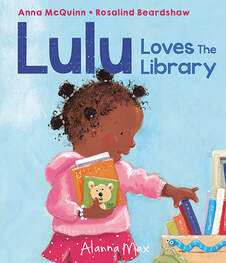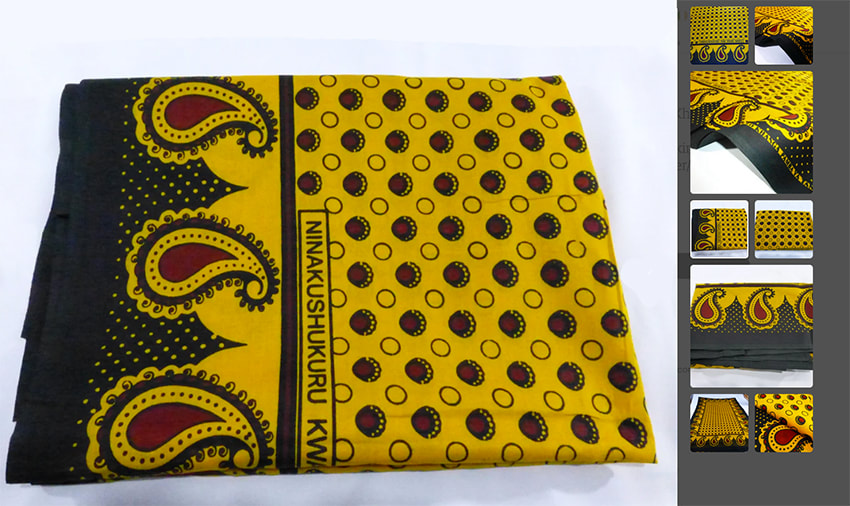|
Kanga - an inspirational fabric from Tanzania
Picture book authors and illustrators often spend HUGE amounts of time building in layers of things for readers to notice and uncover on second, third, fourth... readings. We know that our stories will be read multiple times and that children are skilled at noticing the tiniest of details (many are 'reading' the pictures more than the words at this age).
It is always gratifying when adult readers, reviewers, critics etc notice these details and are delighted by them - the piece is dedicated to one of those close readers who notices EVERYTHING - Fabia of Candid Cocoa and founder of the Jericho Prize. |
Some background...
When I wrote the first Lulu stories, I was working part time as a Community librarian for a Sure Start project.
Most of my work was running groups for babies, toddlers and young children and their families in the library; doing outreach to make the local community aware of these groups and to encourage families to join and use the library.
Working closely with families when their children are very small can often lead to deep friendships - some families attended one of my groups with their first child, then a second, third... so we met a few times a week over 14 years!
When I wrote the first Lulu stories, I was working part time as a Community librarian for a Sure Start project.
Most of my work was running groups for babies, toddlers and young children and their families in the library; doing outreach to make the local community aware of these groups and to encourage families to join and use the library.
Working closely with families when their children are very small can often lead to deep friendships - some families attended one of my groups with their first child, then a second, third... so we met a few times a week over 14 years!
|
It's not hard to imagine that many of these children were in my mind as I developed Lulu's, and later Zeki's, character. And many parents kindly worked with me on some of the books giving me feedback and often photographic reference for all sorts of things.
Many of thes much-loved children in my mind as I wrote. However, I felt that even as I incorporate parts of them (and me) into her character, it was important that Lulu not just be an amalgam of them all, but be herself with a definite personality and heritage. So, I decided that her mother would be originally from Tanzania (just like one of the little girls in my group). |
|
So, when it came to acknowledging that heritage, I looked to East African fabrics for inspiration. While many people are familiar with Kente fabric from Ghana/West Africa, people are generally less aware of the Khanga fabrics from Tanzania/East Africa that have provided so much inspiration for me and for the illustrators of Lulu and Zeki. We have fallen more and more in love with the patterns, and Kanga has appeared more and more as an inspiration in the books. So I would like to share with you our favourite khangas. Kanga |
|
Kanga or Khanga * is a rectangular shaped, 100% cotton, printed cloth common all along the coast of East Africa, especially Tanzania and Kenya. It is distinctive in having patterns of contrasting scale - one in the centre (mji) and one around the edges (pindo). Each piece usually also includes Swahili text (ujumbe or jina) often a proverb. Kanga is extremely popular in East Africa and is worn daily by millions of women. Kangas are very popular gifts especially for birthdays and weddings. If you are a guest at somebody’s house then they may present you with your own kanga, which is a sign of friendship. *I use the simpler kanga spelling since the Lulu books are written for young children and it's easier for them. |
|
History
Kangas have existed in East Africa since the mid 19th century. There are many stories as to the origins of Kanga... One of the most common among historians points to the Indian Portuguese influence on East Africa of those who travelled the spice route and traded using fabrics. They say that in the 1870s, the women in Zanzibar and Mombasa bought printed bandanas, imported by Portuguese traders. They sewed six of these colourful bandanas together to make a unique piece of cloth. Traders along the Swahili coast quickly reacted to this emerging trend and arranged for designs to be hand-stamped, using carved wooden blocks, onto a single piece of locally woven cloth instead of lots of smaller squares sewn together. All of the histories agree that the first local versions were block printed with repeating black and white spotted motifs and that gave the cloth the name Khanga or Kanga - after the Swahili word for the spotted black and white guinea fowl. Swahili proverbs were added to kanga designs at the beginning of this century. The paisley pattern that is extremely common in Kanga may also be a throwback to those Portuguese bandanas - though the Kanga has made its own of the pattern. |
Kanga Sayings - (ujumbe or jina)
For me, the most fascinating thing about the kangas is that each one bears a message; sometimes a Kiswahili proverb, sometimes a political slogan, sometimes a very personal message from the giver to the receiver.
These messages are known as Jina or ujumbe and they are many and varied. Short and to the point, they carry a whole lot of meaning. Naturally, these messages are especially shared by women who will wear a specific kanga to communicate a non-verbal message to their community. This form of communication, often between women, can be about personal feelings, relationships, politics, education, health or religion.
While I was researching the many Jina, I came across this story (click here for the original).
A young Tanzanian girl recounted how she became engaged to a German man and that in her area this caused much talk. She bought herself two kangas: on the one was the message – Wasemao na waseme – Let them talk who want to talk; on the other was written, Moyo ndiye muamuzi – Only the heart decides. She reported that the talk soon stopped once she appeared wearing these!
These messages are known as Jina or ujumbe and they are many and varied. Short and to the point, they carry a whole lot of meaning. Naturally, these messages are especially shared by women who will wear a specific kanga to communicate a non-verbal message to their community. This form of communication, often between women, can be about personal feelings, relationships, politics, education, health or religion.
While I was researching the many Jina, I came across this story (click here for the original).
A young Tanzanian girl recounted how she became engaged to a German man and that in her area this caused much talk. She bought herself two kangas: on the one was the message – Wasemao na waseme – Let them talk who want to talk; on the other was written, Moyo ndiye muamuzi – Only the heart decides. She reported that the talk soon stopped once she appeared wearing these!
My favorite Kanga messages are:
Kuelekeza si kufuma – To aim is not to hit (Good intentions alone serve nothing if not followed by tangible results.)
Usisafirie nyota ya mwenzio – Don't set sail using someone else's star
Furaha yako ni furaha yangu – Your joy is my joy
Mama ni malkia; thamani yake haina kifani – The mother is a queen; her value is inestimable
Mama ni nambari wani; hana mpinzani – Mother is number one; she has no one against her.
Usinisumbue – Don’t bother me
Akili ni mali – Wits are wealth
Sina siri nina jibu – I have no secrets but I have an answer
I'm on a mission to find out what the sayings on my favourite kangas shown above are - I'll fill them in as I find them.
Kuelekeza si kufuma – To aim is not to hit (Good intentions alone serve nothing if not followed by tangible results.)
Usisafirie nyota ya mwenzio – Don't set sail using someone else's star
Furaha yako ni furaha yangu – Your joy is my joy
Mama ni malkia; thamani yake haina kifani – The mother is a queen; her value is inestimable
Mama ni nambari wani; hana mpinzani – Mother is number one; she has no one against her.
Usinisumbue – Don’t bother me
Akili ni mali – Wits are wealth
Sina siri nina jibu – I have no secrets but I have an answer
I'm on a mission to find out what the sayings on my favourite kangas shown above are - I'll fill them in as I find them.
It has been wonderful to see the kanga patterns become part of the influences and source of inspiration for the art for these books.
|
Khanga provided Ruth Hearson (Zeki's illustrator) with a wonderful inspiration for the patterns on the fabrics for Zeki Loves Mummy and Zeki Loves Daddy. Click here or on the cover to see the wonderful results. |
Lots of readers loved Lulu's wonderful kanga dress in Lulu's Sleepover, and in the upcoming Lulu's Nana-Bibi Comes to Visit, Ros Beardshaw has been hugely inspired by Nana's trip from Tanzania.
See here or click on the cover! |
What I love most is how these varied colours and patterns express the East African womens' spirit in they way they put patterns and colurs together with amazing creativity and confidence.



















